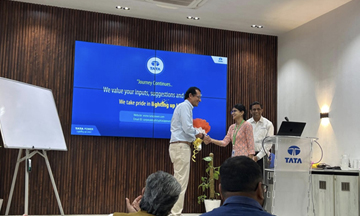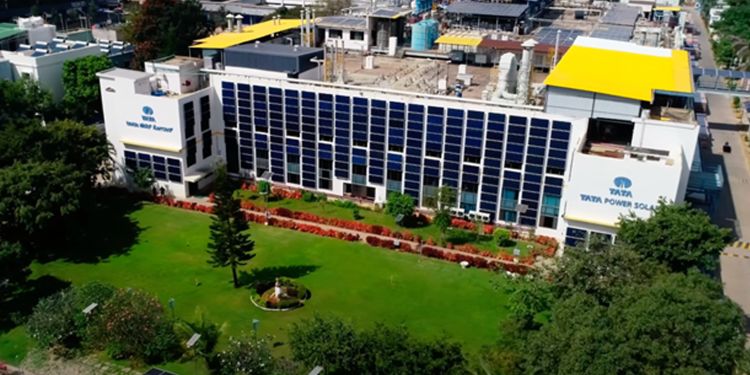Professor Vikram Gandhi’s Immersive Field Course (IFC) “Development while Decarbonizing: India’s Path to Net-Zero" delved into the critical aspect of decarbonization and sustainability goals amid India's rapid development. The course presented an opportunity for students to advance their knowledge of sustainability efforts, decarbonization, and net zero in the context of a broader development agenda. The class culminated in a series of site visits in January 2025 in Mumbai and Bangalore and this is one of 9 student essays that highlights their reflections on uncovering sustainable solutions across the country.
In the bustling city of Bangalore, where tradition meets technology, we had the privilege of visiting the Tata Solar manufacturing facility. This visit offered a window into India’s renewable energy journey, showcasing both significant achievements and challenges ahead. Tata Power Solar, a subsidiary of Tata Power, epitomizes India’s ambition to lead the global shift towards sustainable energy. As one of India’s oldest and most respected power companies, Tata Power has consistently reinvented itself—from its hydropower origins in 1910 to its current focus on solar and renewable energy.

The Strengths of Tata Solar’s Manufacturing Facility
Walking through the manufacturing lines, it was clear that Tata Solar is pushing the boundaries of India’s solar energy capabilities. The facility demonstrated a commendable degree of automation compared to other plants we visited during this field course. From solar cell to module assembly, the processes showcased precision and commitment to quality.
Tata Solar has been a leader in the solar industry for over 33 years, combining a legacy of excellence with innovative solutions for residential, commercial, and rural applications. Their focus on Industry 4.0 practices, including digitalization and automation, has positioned them to meet India’s ambitious renewable energy goals while fostering a diverse and inclusive workplace. Notably, Tata Power’s step-down arm, TP Solar Ltd., recently commenced commercial solar cell production at its 4.3 GW integrated cell and module plant in Tirunelveli, Tamil Nadu. This new facility, India’s largest single-location PV cell and module manufacturing plant. The plant is expected to achieve full-scale production within a few months, highlighting Tata Solar’s commitment to indigenization and self-reliance in the solar value chain. Leadership’s investment in cutting-edge solar production aligns seamlessly with India’s renewable energy targets of 500 GW by 2030. The company’s positioning as a reliable domestic supplier also reflects India’s geopolitical strategy to reduce dependence on Chinese imports under the “China plus one” policy.
One of the highlights of our visit was learning about Tata Solar’s innovative bifacial photovoltaic (PV) modules, which capture sunlight on both sides to enhance efficiency. This technology not only underscores Tata’s engineering excellence but also their commitment to delivering sustainable solutions at scale.

Challenges to Overcome
While Tata Solar’s contributions to India’s renewable energy landscape are commendable, our visit also highlighted areas for improvement. A key concern remains the facility’s dependency on China for critical inputs such as silicon wafers, automated equipment, and skilled labor. This reliance poses a significant risk to Tata Solar’s long-term scalability and self-reliance.
Facility optimization is another area of focus. The Bangalore facility, though impressive, was noted to be less automated and organized compared to industry-leading global plants. Leadership acknowledged these gaps and highlighted plans for newer, state-of-the-art facilities to address these shortcomings.
Another challenge lies in Tata Solar’s defect rate, particularly in intermediate steps where a 4% defect rate was observed. This rate, while manageable, could benefit from stricter cleanroom practices and further automation to reduce rework costs and enhance overall efficiency.
A broader concern is the lack of intellectual property or unique product differentiation. As the global solar industry becomes increasingly competitive, creating a distinct technological edge will be crucial for Tata Solar to remain competitive against low-cost Chinese manufacturers.
Opportunities for Improvement
Tata Solar’s leadership is aware of these challenges and is actively working to address them. One promising opportunity lies in building a robust local supplier ecosystem. By investing in second- and third-tier suppliers, Tata Solar could reduce dependency on imports and enhance cost efficiency.
Further investments in cleanroom practices and automation could significantly improve product quality and yield rates. Additionally, expanding leadership in operations and research and development (R&D) could drive innovation and align the company with global industry trends.
Leadership’s Strategic Vision
Our discussions with Tata Solar’s leadership highlighted the broader geopolitical and economic rationale for their strategy. India’s renewable energy policies, such as Production Linked Incentives (PLI), aim to build domestic capacity and reduce reliance on imports. Tata Solar is well-positioned to benefit from these incentives while contributing to India’s solar development goals.
Leadership also emphasized the importance of balancing cost and geopolitics. In their corporate video, Tata Solar underscored their role in transforming rural India through innovative solar solutions, such as solar water pumps and floating solar projects, which provide both economic security and environmental benefits to underserved communities. While Chinese panels remain cheaper, the demand for domestic manufacturing is driven by the need for supply chain resilience and independence. This strategy is particularly relevant given the massive demand for solar energy in India, which far exceeds the current domestic production capacity.
Cultural and Organizational Observations
During our visit, we participated in a tree plantation and garlanding ceremony organized by Tata Solar, led by Prof. Gandhi and the renewables team. This event underscored the company’s deep commitment to sustainability and environmental stewardship, values rooted in the ethos of their founder, Jamshed Ji Tata. One remarkable story shared by the team was how, over 100 years ago, Jamshed Ji Tata saw smoke plumes rising from a thermal power plant and challenged his engineers to explore cleaner ways to generate power—leading to the establishment of Tata’s first hydroelectric power plant. This long term vision for sustainability continues to inspire Tata Solar’s mission today.
One of the most inspiring aspects of Tata Solar is its alignment with Tata Group’s values. One of the focus of Tata Solar is empowering women in manufacturing, showcasing a workplace where women are breaking barriers and thriving in roles traditionally dominated by men. These initiatives not only foster diversity and inclusion but also tap into a broader talent pool, strengthening the company’s workforce. Such efforts reflect Tata Solar’s broader mission of creating equitable and sustainable solutions for the future.

The company’s emphasis on employee loyalty and organizational culture was evident during our visit. Leadership’s commitment to honoring employees fosters a sense of belonging and dedication that extends across the organization. However, as Tata Solar scales, ensuring the scalability of these cultural practices will be critical.
A Vision for the Future
Tata Solar’s journey is emblematic of India’s broader renewable energy ambitions. The company stands as a beacon of innovation, resilience, and commitment to sustainability. While challenges remain, Tata Solar’s strategic vision, technological investments, and alignment with national policies position it as a key player in driving India’s transition to a greener future.

As we reflect on this visit, it is clear that Tata Solar represents both the opportunities and challenges inherent in India’s renewable energy journey. The company’s ability to innovate, adapt, and scale will determine its success in contributing to India’s ambitious renewable energy goals. For those of us privileged to witness this journey up close, Tata Solar serves as a powerful reminder of the transformative potential of sustainable innovation.
Sources
- Some pictures extracted from publicly available Tata Power Solar Corporate Video - https://www.youtube.com/watch?v=21ZDMdEtp0M&t=5s
- Tata Power Solar Website - https://www.tatapowersolar.com/
- Tata Solar Bangalore Manufacturing facility walkthrough and Tata Solar Leadership interview conducted by the authors.

